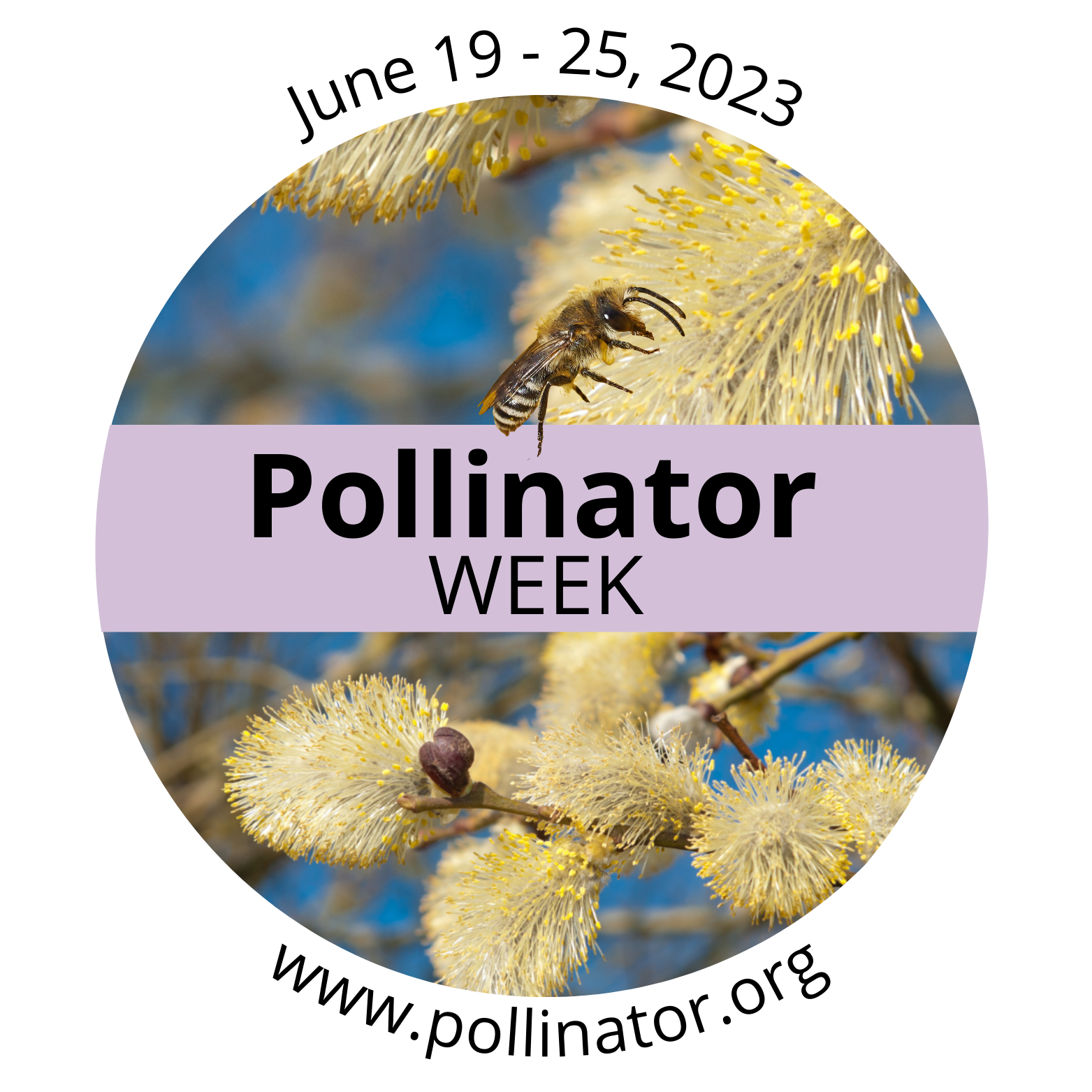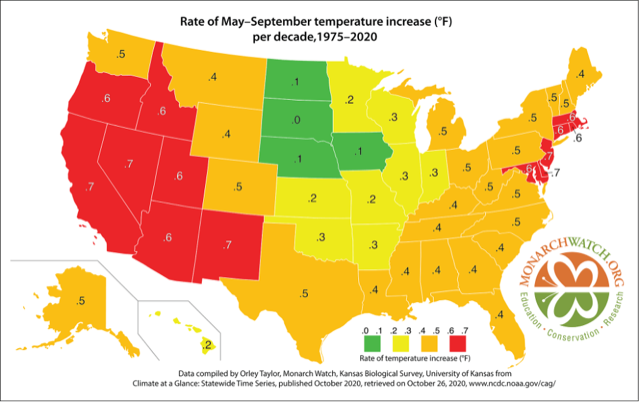The following blog post was originally posted by Farmers for Monarchs – a Keystone Collaborative.

The vast majority of farmers recognize the impact of climate change. The 2020 Iowa Farm and Rural Life Poll survey explored farmers’ perspectives on climate change and ways that farmers can address its impacts on agriculture. The survey found that 81% of farmers indicated that climate change is occurring and over half reported that they are concerned about the potential impacts of climate change on their farm operations.
Both farmers and pollinators like the monarch coexist in a delicate lifecycle subject to the ebbs and flows of the environment. Just as a farmer’s livelihood is impacted by climate change, so is the life cycle of the monarch. Farmers for Monarchs has previously written how the monarch butterfly population has been impacted by climate change. It is not just about the types of forage and resources that monarchs need to survive but the timing of when those resources are available. The migratory generation of monarchs that departs for their overwintering grounds each fall relies on late season wildflowers to fuel their flight. As with farming, overwintering monarchs require “Goldilocks” type conditions – not too hot, not too cold – to survive the winter without freezing and without using too much of their energy reserve. In their final attempts to get the next generation off to a good start, the overwintering generation moves north and relies on abundant spring milkweed that is well-timed with their arrival in the southern U.S. As subsequent generations move north following their milkweed host plants, weather conditions in different geographies might delay them, or push them ahead too quickly. Summer breeding generations need abundant milkweed and nectar resources to help build a robust migratory generation come fall, and then the cycle begins again. With this multi-generational migration cycle, you can see how disrupting just one link in this chain can be detrimental to the success of subsequent generations, and thereby the entire population.
We’ve already seen examples of these disruptions in recent years. Last month we shared the encouraging news of a robust western monarch population that was counted at the end of 2022. Powerful winter storms in California, however, are threatening this year’s breeding cycle. Significant winter storms in Texas in recent years have also knocked back plant vegetation, bringing speculation about whether or not native milkweeds would have enough time to bounce back before the monarchs arrived. Luckily, they did in 2021, but the monarch may not be so lucky in the future. Severe drought conditions across the western landscape are also cause for concern. It is difficult to grow plants – crops or native plants – without water. And on the inverse, significant flooding in the Midwest in recent years have taken a toll on both agriculture production and forage for monarchs and pollinators.
The Iowa Farm and Rural Life poll also found that nearly 60% of farmers agreed that they should take steps to protect the land they farm from severe weather events like precipitation. Some of these steps farmers can take to protect their land can also be beneficial for monarchs, such as developing widespread habitat that include diverse plant species. More habitat simply makes it easier for monarchs to find suitable plants on which to lay eggs or find nectar or a mate. Additionally, pollinator plantings on non-crop lands protect against erosion and can act as a carbon sink.
Keystone Policy Center’s Farmers for Monarchs collaborative stands ready to assist farmers meet their conservation goals. Simply contact the Pollinator Habitat Help Desk at (337) 422-4828 or (337) HABITAT for more information on planting milkweed and other pollinator habitat on your land, or participating in cost-sharing programs like the Conservation Reserve Program.



 Shelby Coffey III is a distinguished journalist, media executive, and thought leader whose career has helped shape the landscape of American news and public discourse. Over several decades, Coffey has held some of the most influential roles in journalism, including serving as editor of the Los Angeles Times, executive vice president of ABC News, and deputy managing editor of The Washington Post. His editorial leadership extended to key roles as president of CNN Financial News, editor of the Dallas Times Herald, and U.S. News & World Report.
Shelby Coffey III is a distinguished journalist, media executive, and thought leader whose career has helped shape the landscape of American news and public discourse. Over several decades, Coffey has held some of the most influential roles in journalism, including serving as editor of the Los Angeles Times, executive vice president of ABC News, and deputy managing editor of The Washington Post. His editorial leadership extended to key roles as president of CNN Financial News, editor of the Dallas Times Herald, and U.S. News & World Report. Effective March 1, 2025, Thomas J. Vilsack, former United States Secretary of Agriculture and Governor of Iowa, became the first Chief Executive Officer for the World Food Prize Foundation. In this new role, Governor Vilsack is focusing on expanding the Foundation’s global network, and will further position the Foundation as a leader in addressing global food and nutrition insecurity, continuing his lifetime of public service.
Effective March 1, 2025, Thomas J. Vilsack, former United States Secretary of Agriculture and Governor of Iowa, became the first Chief Executive Officer for the World Food Prize Foundation. In this new role, Governor Vilsack is focusing on expanding the Foundation’s global network, and will further position the Foundation as a leader in addressing global food and nutrition insecurity, continuing his lifetime of public service. Jerry Steiner has spent 40 years involved in agriculture following growing up on a Wisconsin dairy farm. He began his career with Monsanto, in multiple business leadership roles. From 2003-2013 he served as a member of the Executive team, as the company’s Executive Vice President of Sustainability and Corporate Affairs. He led the company’s global Government, Public and Industry Affairs teams across the 70 countries where Monsanto conducts business. This experience got Jerry connected to the Keystones centers work in agriculture. Key among his responsibilities were shaping the company’s public policy and building partnerships aimed at helping farmers around the world produce more food, while conserving valuable resources like water and energy. Two unique partnership that developed under his leadership were drought tolerant corn with 5 African countries, CIMMYT and the Gates foundation, and a building a sustainable business model in Brazil with the value chain leading to significant multi-company investment and soybean varieties that can protected themselves.
Jerry Steiner has spent 40 years involved in agriculture following growing up on a Wisconsin dairy farm. He began his career with Monsanto, in multiple business leadership roles. From 2003-2013 he served as a member of the Executive team, as the company’s Executive Vice President of Sustainability and Corporate Affairs. He led the company’s global Government, Public and Industry Affairs teams across the 70 countries where Monsanto conducts business. This experience got Jerry connected to the Keystones centers work in agriculture. Key among his responsibilities were shaping the company’s public policy and building partnerships aimed at helping farmers around the world produce more food, while conserving valuable resources like water and energy. Two unique partnership that developed under his leadership were drought tolerant corn with 5 African countries, CIMMYT and the Gates foundation, and a building a sustainable business model in Brazil with the value chain leading to significant multi-company investment and soybean varieties that can protected themselves. Jennifer Morris is the Chief Executive Officer of The Nature Conservancy, leading a team of nearly 6,000 staff working in more than 80 countries and territories tackling the dual crises of the
Jennifer Morris is the Chief Executive Officer of The Nature Conservancy, leading a team of nearly 6,000 staff working in more than 80 countries and territories tackling the dual crises of the  Congressman Joe Neguse represents Colorado’s 2nd District in the U.S. House of Representatives. He was elected to his first term in November 2018, becoming the first Black Member of Congress in Colorado history. In December 2022, Rep. Neguse was elected by his colleagues to serve as Chair of the Democratic Policy and Communications Committee (DPCC), becoming the first Coloradan to serve in a senior elected leadership role in the House in over 85 years. He serves on the Natural Resources and Judiciary Committees, and was also appointed by House Minority Leader Hakeem Jeffries to serve as one of four Democrats on the prestigious Rules Committee. Rep. Neguse serves as Ranking Member on the House Subcommittee on Federal Lands, which he previously Chaired in the 117th Congress.
Congressman Joe Neguse represents Colorado’s 2nd District in the U.S. House of Representatives. He was elected to his first term in November 2018, becoming the first Black Member of Congress in Colorado history. In December 2022, Rep. Neguse was elected by his colleagues to serve as Chair of the Democratic Policy and Communications Committee (DPCC), becoming the first Coloradan to serve in a senior elected leadership role in the House in over 85 years. He serves on the Natural Resources and Judiciary Committees, and was also appointed by House Minority Leader Hakeem Jeffries to serve as one of four Democrats on the prestigious Rules Committee. Rep. Neguse serves as Ranking Member on the House Subcommittee on Federal Lands, which he previously Chaired in the 117th Congress. Llewellyn King was born in Southern Rhodesia, now Zimbabwe. He went into journalism as soon as he turned 16, stringing for Time magazine and United Press in Africa.
Llewellyn King was born in Southern Rhodesia, now Zimbabwe. He went into journalism as soon as he turned 16, stringing for Time magazine and United Press in Africa. Steven Williams is the Chief Executive Officer of PepsiCo North America, overseeing a more than $48 billion business that spans PepsiCo’s Foods and Beverage operating units. His leadership encompasses more than 125,000 associates and over 900 locations across the U.S. and Canada. Steven joined PepsiCo in 2001 as part of PepsiCo’s acquisition of the Quaker Oats Company, which he joined in 1997, and has held leadership positions of increased responsibility since.
Steven Williams is the Chief Executive Officer of PepsiCo North America, overseeing a more than $48 billion business that spans PepsiCo’s Foods and Beverage operating units. His leadership encompasses more than 125,000 associates and over 900 locations across the U.S. and Canada. Steven joined PepsiCo in 2001 as part of PepsiCo’s acquisition of the Quaker Oats Company, which he joined in 1997, and has held leadership positions of increased responsibility since.